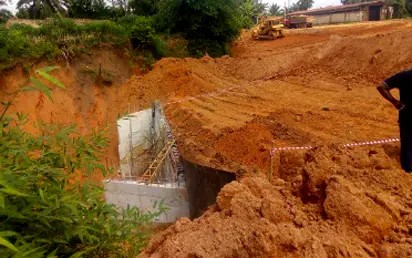
ON August 10, 2021, Vanguard, once again, raised the alarm over the erosion cataclysm in Southern Nigeria. It narrated in graphic details how residents of Ndokwa East in Delta State go to the farm or market, only to return to meet their homes swept away by flood and gully erosion.
The Onyah enclave, Utuoku, Okpai, Adiai-Obiaku, Utchi, Abala-Oshimili, Aboh, Okpai, Beneku, Utuoku, Asaba-Ase and other oil-producing communities that lay the golden eggs for Nigeria’s economy have been mostly devastated over the years. According to the Vanguard report, indigenes of these affected communities have been crying out for help, but no government has come to their rescue.

In July 2018, the World Igbo Environmental Foundation, WIEF, rolled out a frightening environmental statistic. The Foundation conducted a study which found that there are over 2,800 active erosion sites in the South East of Nigeria alone.
According to the report, Anambra State has over 1,000 active erosion sites. In Imo, there are about 300 sites, while Abia, Enugu and Ebonyi have about 500 sites of active erosion each. These gully erosions are threatening to sack many communities in the region from their ancestral lands.

Although climate change has been identified as the major factor responsible for the erosions, anthropogenic factors such as faulty road constructions and drainage systems, logging, grazing, mining, unsustainable agricultural practices, deforestation and all manners of environmental degradations by humans have also been blamed.
Besides rendering residents homeless, soil erosion is a major factor for desertification. It can transform habitable regions into deserts, lead to loss of biodiversity, soil degradation and alteration of the ecosystem.
As WIEF observed, it is obvious that government at various levels have not done enough to check erosion in the South East because the institutions and policies that guarantee sustainable environment are either non-functional or completely lacking. Gully erosions do not start overnight; there are processes leading to them and they can be stopped.
With erosion menace, it appears the candle of the neglected South East of Nigeria is burning at both ends and may in no distant time plunge the region into economic and environmental darkness.
But regardless of the substantial damage already done, erosion in the South East can still be curbed by massive tree planting, introduction of mulch and rocks to the soil to reduce erosion on the slopes, and creating of fibre logs to prevent soil from washing away. In addition, every household should have a proper drainage system to enable water flow into proper waterways.
In view of the capital intensiveness of these measures, they are beyond the financial capabilities of the erosion-ravaged regions. The state and federal governments, the United Nations and other international agencies must join hands to address the problem of erosion in Nigeria, especially the South East.
Credit: Vanguard Nigeria
